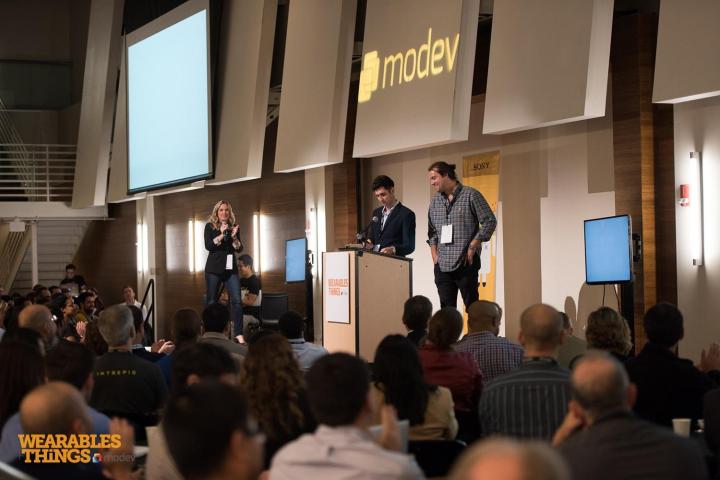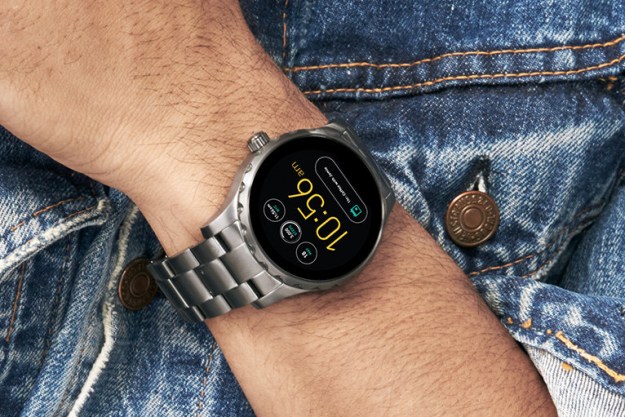
Called Dorothy (what else?), the gizmo is a tiny Bluetooth-powered gadget that sits in your shoe and can connect to your phone via a microcontroller. Built by DJ Saul and Taylor Guidon from iStrategyLabs, the device is a still a prototype, and admittedly a little large. They’re working on better prototypes, Saul said, and a way to embed it into an insole. But it’s got massive potential.
“We view this a physical trigger for the If This Then That [IFTTT] universe,” Saul said.
“The amount of innovation I’m seeing today is truly astonishing.”
It seems like they were all being shown off Monday. Minutes after Saul and Guidon, Peter Li of Atlas Wearables strode on stage to show off his new gadget, the first ever live demo of a smartwatch for fitness that can do the seemingly impossible.

“What if a device could actually recognize specific motions you’re doing, down to a granular level?” he asked. Using a fine-tuned motion sensor tied to a heart-rate sensor, it can do just that, detecting not just that the wearer is exercising but which exact exercise he’s doing.
Before a crowd of developers and wearable enthusiasts, the young CEO tossed off a set of jumping jacks and push-ups, dutifully recorded by the oversize black hunk on his wrist. Someone from the crowd called out for burpees; Li didn’t miss a bit, dropping to the ground for a few sets that were immediately recorded on his wrist.
The Atlas watch will launch with 50 to 100 exercises preprogrammed, and will provide recommendations on form as well as suggestions about which exercises you should be doing, he said.
Not bad, considering Li is under 25. Innovation is a young man’s game. Wearables, however, are women’s work – at least according to Steve Hegenderfer.
“The male body is pretty ugly,” he said, explaining why the very first wearable — clothing — simply had to be a woman’s invention. “It was just a practical thing. Cover that thing up.”
“What if a device could actually recognize specific motions you’re doing, down to a granular level?”
“The amount of innovation I’m seeing today is truly astonishing,” he said.
Despite the innovative gear on display, wearables often equate to health monitors and smartwatches in the public eye, areas that were certainly a part of the day’s keynotes and panels. Hegenderfer acknowledged that, describing how a Bluetooth-based health tracker coupled with an iPad helped save his ailing mother’s life.
“Wearables are very important to me and my family. Wearables are extremely important to me and my family,” he said.
The conference also featured Kristian Tarnhed, senior product planner for Sony Mobile (which used to be called Sony Ericsson), who told the crowd he hails from Lund, the same town in Sweden where Bluetooth was invented.
- 1. DJ Saul and Taylor Guidon invented ‘magic slippers.’ (Image: Modev)
- 2. Timothy Jordan is Google’s wearable guru. (Image: Modev)
Tarnhed developed the latest wearables for the Japanese giant, including the SmartWatch 3, which was unveiled at the IFA show in Germany last month (we tried it out, and called it a big leap forward for the company).
The day began with a keynote by Timothy Jordan, Lead Developer Advocate for Google and the man when it comes to Android Wear. Jordan walked the crowd through the process of building an app for Android Wear, which he called “the easiest way to get started with wearables” — especially in light of the new software.
“It’s never been easier than with Android Lollipop to build across devices,” Jordan said.
With so many wearable gadgets flooding out now, that’s certainly a good thing.
Editors' Recommendations
- Tech gifts in stock with holiday delivery: Apple Watch, Fire HD tablet
- Wondercise wants you to exercise with perfect form without costly equipment
- Quirky Honor Watch ES puts a fitness coach on your wrist
- Honor’s MagicWatch 2 wins at fitness tracking, but fails to set itself apart




